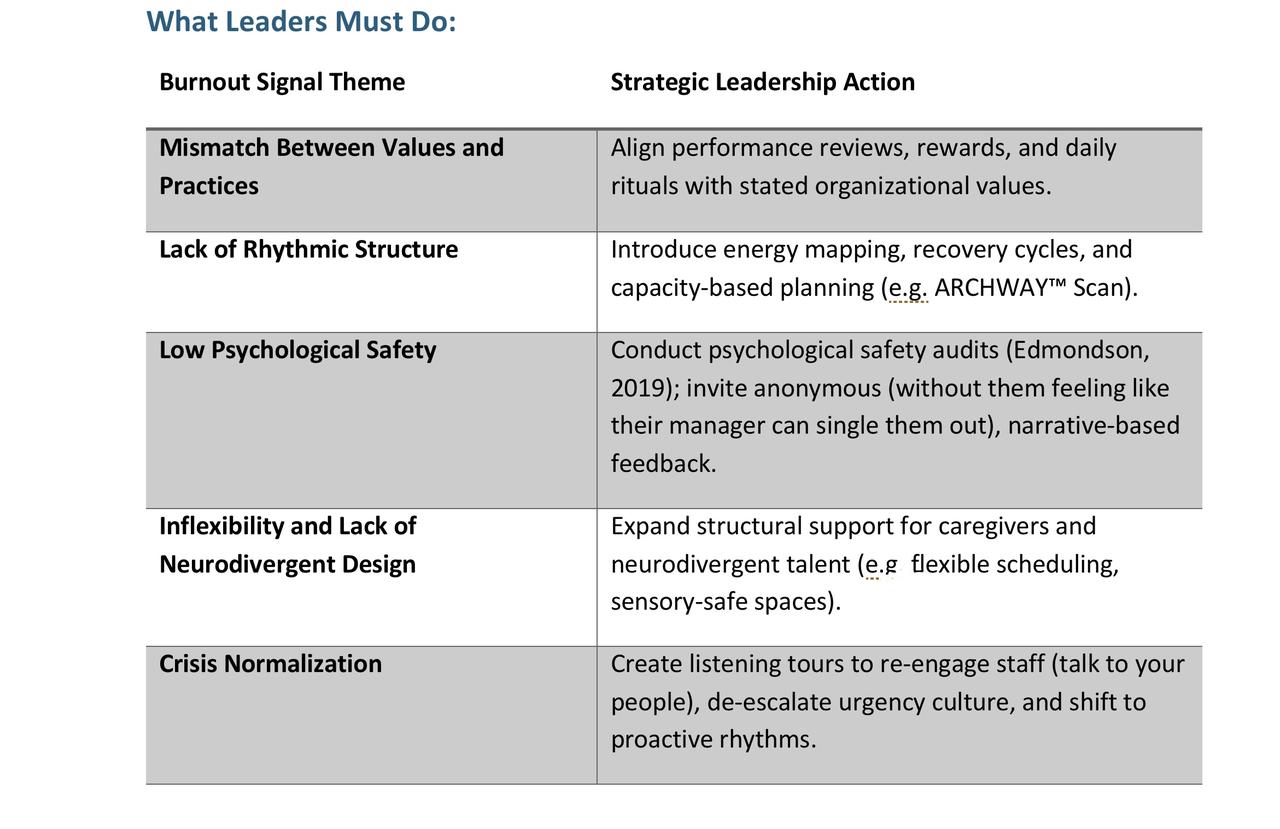
This is the second question in a four-part series of Q&A with Leadership Archway. I invite you to read the blog post the started it all Global Rhythms and Wisdom: Where is the burnout?
At Leadership Archway™, we focus on recognizing patterns, interpreting signals, and responding with strategically attuned leadership and regenerative design. Burnout keeps getting treated like a personal malfunction; yes, I’ve said this before, and I’ll keep saying it. We throw wellness perks and quick fixes at it, maybe offer a little time off, but nobody’s asking why the system keeps breaking people in the first place (If you want to find out about the real definition of burnout click here.) However, burnout may be better understood as a collective feedback mechanism, a form of cultural data insights indicating underlying challenges related to organizational design, operational pace, or power dynamics.
Burnout is not weakness, it is the workforce whispering what no one has permission to say out loud, HELP!
What Burnout Signals Look Like: The Hidden Patterns
Research shows that burnout rarely shows up all at once, it emerges in layers of signal degradation. Here are the early warning signs across a system:
1. Attrition & Turnover Spikes
a. High-performing employees begin to exit.
b. New hires don’t stay long.
c. Exit interviews cite “culture misfit” or “lack of sustainability” more than compensation.
👉 Insight: Attrition is a vote of no confidence in the system. It’s not just people leaving jobs, it’s people leaving cultures that ignore capacity.
2. Quiet Quitting & Disengagement
a. Employees do the bare minimum and stop volunteering new ideas.
b. Innovation stalls.
c. Participation in team rituals or communications drops off.
d. According to Gallup, only 21% of employees globally feel engaged, and disengaged employees cost the world economy an estimated $8.8 trillion in lost productivity.
👉 Insight: Silence isn’t laziness, it’s often protection. People pull back when they no longer trust that their effort will be honored.
3. Over-Functioning by Top Performers
a. High achievers work long hours, skip breaks, and never say no.
b. They carry the emotional and operational load for everyone else.
c. They get rewarded for this—until they crash.
👉 Insight: This “hero” behavior is a trauma-informed survival mechanism. It reflects internalized fear that pausing = irrelevance.
4. Micro-signals of Systemic Misalignment
These may include:
a. Late or vague communication
b. Repeated requests for “clarity” on simple tasks
c. Passive-aggressive feedback or absenteeism
d. Reversion to rigid processes when uncertainty increases
👉 Insight: These are not employee issues, they are symptoms of unresolved systemic stress.
5. Emotional Labor and the Invisible Load
a. Employees are managing their own burnout and the emotional needs of their peers or managers.
b. DEI champions are advocating without resources.
c. Caregivers are expected to “balance” everything without structural support.
👉 Insight: Burnout is not “too much work,” it’s too much unacknowledged work with too little systemic repair.
The Common Threads: What the Signals Reveal
Across industries, roles, and cultures, burnout signals tend to cluster around five core themes:
1. Mismatch Between Values and Practices
2. Lack of Rhythmic Structure
3. Low Psychological Safety
4. Inflexibility and Lack of Neurodivergent Design
5. Crisis Normalization
From a neuroscience perspective, burnout can be understood as the result of prolonged sympathetic nervous system overactivity, continuous stress without repair. In organizational systems, this manifests as:
· Cognitive overload
· Trust erosion
· Reduced psychological safety
· Emotional detachment
· Culture degradation
But here's the shift:
Burnout isn't just a breakdown, it's a map of misalignment. When leaders learn to decode these signals, they gain a blueprint for systemic, strategic change.

Burnout is not the end of the story; it’s the beginning of intelligent design. When leaders learn to see each signal as an opportunity for alignment, they move from reactive to regenerative. Imagine the shift from fire drills to foresight and from extraction to evolution.
Final Thought: Burnout isn’t a crisis but a signal for change so, don’t ignore it, use it. Like a compass during a storm, it points to what needs adjustment and highlights areas for improvement. Let it guide you toward growth. Leadership Archway™ helps interpret these signals, so you or your organization arrive at the destination.